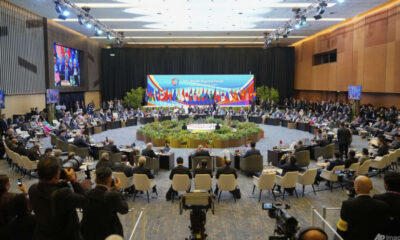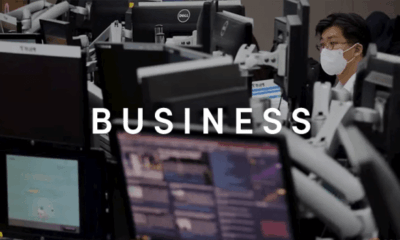Politics
Taiwan Conducts Extensive Military Drills Amid Rising Threats

Taiwan has launched its most comprehensive military exercise to date, the 40th Han Kuang, which runs for ten days and simulates a potential full-scale invasion by the People’s Liberation Army (PLA). This extensive drill features amphibious assaults, joint-force coordination, and significant integration of civilian-military capabilities across various domains. In this context, Taiwan is demonstrating enhanced deterrent capabilities with advanced weaponry, including US-supplied HIMARS rocket systems, F-16V fighter jets, and indigenous Sky Sword II and Sky Bow III missile systems.
A pivotal aspect of this exercise is the activation of 22,000 reservists, marking an unprecedented mobilization of national defense forces. This reflects Taiwan’s commitment to preparing for possible conflict rather than solely focusing on deterrence. The shift is a direct response to the increasingly aggressive maneuvers from the PLA, which have included a significant rise in aircraft and naval incursions across the Taiwan Strait’s median line. Such incursions surged from 565 in 2022 to over 3,070 in 2024, averaging more than eight per day.
Taiwan is no longer adopting a passive stance regarding external support. Instead, it is developing an active and layered defense strategy to address the volatile security landscape. This recalibration has drawn attention from Taiwan’s strategic partners, particularly members of the Quadrilateral Security Dialogue (QUAD), which comprises the United States, Japan, India, and Australia.
QUAD’s Evolving Role in Regional Security
Initially established as a maritime security initiative, the QUAD has expanded into a broader Indo-Pacific framework aimed at ensuring a free, open, and rules-based regional order. Nevertheless, the situation surrounding Taiwan reveals the group’s limitations. Unlike NATO, the QUAD lacks formal military alliance status and binding mutual defense commitments.
The urgency of Taiwan’s situation has prompted discussions on whether the QUAD should establish a more coherent strategy for collective deterrence. Recently, US President Donald Trump urged Australia and Japan to clarify their positions regarding potential conflict over Taiwan. The Pentagon is making efforts to align operational plans with allies, especially Japan and Australia, through consultations and strategic dialogues. Despite these efforts, progress is slow due to political constraints and differing national priorities.
Japan has taken steps to bolster its defense posture, increasing its defense budget from 6.8 trillion yen in 2023 to 8.7 trillion yen by 2025, representing 1.8% of its GDP. The nation has also expanded joint military exercises with the United States and is reevaluating its strategic doctrines. However, constitutional limitations and public ambivalence present challenges. A survey conducted by the Asahi Shimbun indicates that 62% of Japanese citizens regard a regional conflict as likely, yet a majority prefer neutrality and global cooperation, with only 18.7% supporting closer alignment with the United States.
Australia’s approach remains cautious. Prime Minister Anthony Albanese recently undertook a six-day visit to China, underscoring his government’s dual-track strategy of strengthening defense ties with the United States while maintaining robust economic relations with China. Amid US calls for clarity on Taiwan, the Australian government has stated it will not commit troops in advance to any potential conflict. The stakes are significant, as Australian exports to China reached AUD196 billion last year, surpassing the combined total of Australia’s next four largest markets. Estimates from Curtin University suggest that trade with China contributes an additional AUD2,600 to the average Australian household income annually.
India’s Strategic Position and Regional Implications
In contrast, India has maintained a careful silence regarding Taiwan, adhering to its longstanding recognition of the One China policy established in 1949. Despite the rising tensions across the Taiwan Strait, India has refrained from making statements in international forums such as ASEAN to avoid provoking China, particularly given unresolved border disputes in the Himalayas. Nevertheless, India has steadily expanded its engagement with Taiwan. Key companies like Foxconn and Pegatron play significant roles in India’s “Make in India” and “Atmanirbhar Bharat” initiatives, and bilateral trade has increased sixfold since 2001. Ongoing discussions regarding a free trade agreement and semiconductor cooperation indicate a growing economic relationship.
The potential for conflict in the Taiwan Strait poses severe risks to global supply chains, which India is increasingly acknowledging. During the July 2025 QUAD Foreign Ministers’ meeting, members expressed “serious concerns” over rising tensions in the East and South China Seas but refrained from directly condemning China. These strategic and economic divergences highlight the QUAD’s central dilemma.
While the QUAD was not structured for collective military action, the growing assertiveness of China regarding Taiwan necessitates a more coordinated response. Although public statements remain measured, the QUAD must avoid strategic drift to maintain its relevance. Accelerating coordinated efforts in contingency planning, intelligence sharing, and logistical interoperability is essential. The credibility of the QUAD, as well as the broader rules-based order, hinges on its readiness and sustained alignment.
As pressures continue to mount in the Taiwan Strait, the time for strategic ambiguity is diminishing. The stability of the Indo-Pacific region may depend on the QUAD’s capacity to adapt, align, and act decisively. Taiwan is no longer a peripheral issue but has evolved into a critical test of the QUAD’s purpose and unity.
-

 Business5 months ago
Business5 months agoKenvue Dismisses CEO Thibaut Mongon as Strategic Review Advances
-

 Lifestyle4 months ago
Lifestyle4 months agoHumanism Camp Engages 250 Youths in Summer Fest 2025
-

 Sports4 months ago
Sports4 months agoDe Minaur Triumphs at Washington Open After Thrilling Comeback
-

 Sports5 months ago
Sports5 months agoTupou and Daugunu Join First Nations Squad for Lions Clash
-

 Top Stories5 months ago
Top Stories5 months agoColombian Senator Miguel Uribe Shows Signs of Recovery After Attack
-

 World5 months ago
World5 months agoASEAN Gears Up for Historic Joint Meeting of Foreign and Economic Ministers
-

 Health4 months ago
Health4 months agoNew Study Challenges Assumptions About Aging and Inflammation
-

 Business5 months ago
Business5 months agoOil Prices Surge Following New EU Sanctions on Russia
-

 Entertainment4 months ago
Entertainment4 months agoDetaşe-Sabah Violin Ensemble Captivates at Gabala Music Festival
-

 Entertainment4 months ago
Entertainment4 months agoBaku Metro Extends Hours for Justin Timberlake Concert
-

 Top Stories5 months ago
Top Stories5 months agoRethinking Singapore’s F&B Regulations Amid Business Closures
-

 Business5 months ago
Business5 months agoU.S. House Approves Stablecoin Bill, Sends to Trump for Signature









